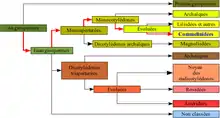Haemodoraceae
La famille des Haemodoraceae (Hémodoracées) regroupe des plantes monocotylédones ; elle comprend moins de cent espèces réparties en une quinzaine de genres.

| Règne | Plantae |
|---|---|
| Sous-règne | Tracheobionta |
| Division | Magnoliophyta |
| Classe | Liliopsida |
| Sous-classe | Liliidae |
| Ordre | Liliales |

| Clade | Angiospermes |
|---|---|
| Clade | Monocotylédones |
| Clade | Commelinidées |
| Ordre | Commelinales |
| Famille | Haemodoraceae |
Ce sont des plantes herbacées, rhizomateuses, tubéreuses ou bulbeuses, pérennes, à rosettes, des régions tempérées à tropicales.
La classification phylogénétique APG II (2003)[1] et la classification phylogénétique APG III (2009)[2] placent aujourd'hui cette famille dans l'ordre des Commelinales.
Étymologie
Le nom vient du genre Haemodorum dérivé du grec αίμα / haima, sang, et δώρων / doron, cadeau[3], en référence à l'emploi des racines de couleur rouge utilisées comme aliment par les aborigènes d'Australie[4]. Le genre a été décrit en 1798 par le botaniste britannique James Edward Smith[5],[6].
Liste des genres
Selon World Checklist of Selected Plant Families (WCSP) (19 avr. 2010)[7] :
- genre Anigozanthos Labill. (1800)
- genre Barberetta (en) Harv., Gen. S. Afr. Pl. (1868)
- genre Blancoa Lindl. (1839)
- genre Conostylis R.Br. (1810)
- genre Dilatris (en) P.J.Bergius (1767)
- genre Haemodorum (en) Sm. (1798)
- genre Lachnanthes (en) Elliott (1816)
- genre Macropidia (en) J.Drumm. ex Harv. (1855)
- genre Phlebocarya (en) R.Br. (1810)
- genre Pyrrorhiza (en) Maguire & Wurdack (1957)
- genre Schiekia (en) Meisn. (1842)
- genre Tribonanthes (en) Endl. (1839)
- genre Wachendorfia Burm. (1757)
- genre Xiphidium Aubl. (1775)
Selon Angiosperm Phylogeny Website (18 mai 2010)[8] :
- genre Anigozanthos Labill.
- genre Barberetta Harv.
- genre Blancoa Lindl.
- genre Conostylis R.Br.
- genre Dilatris Bergius
- genre Haemodorum Sm.
- genre Lachnanthes Elliott
- genre Macropidia J.L.Drumm. ex Harv.
- genre Phlebocarya R.Br.
- genre Pyrrorhiza Maguire & Wurdack
- genre Schiekia Meisn.
- genre Tribonanthes Endl.
- genre Wachendorfia Burm.
- genre Xiphidium Aubl.
Selon NCBI (19 avr. 2010)[9] :
- genre Anigozanthos
- genre Barberetta
- genre Blancoa
- genre Conostylis
- genre Dilatris
- genre Haemodorum
- genre Lachnanthes
- genre Macropidia
- genre Phlebocarya
- genre Schiekia
- genre Tribonanthes
- genre Wachendorfia
- genre Xiphidium
Selon DELTA Angio (19 avr. 2010)[10] :
- genre Anigozanthos
- genre Barberetta
- genre Blancoa
- genre Conostylis
- genre Dilatris
- genre Haemodorum
- genre Lachnanthes
- genre Macropidia
- genre Phlebocarya
- genre Pyrrhorhiza
- genre Schiekia
- genre Tribonanthes
- genre Xiphidium
- genre Wachendorfia
Selon ITIS (20 avr. 2010)[11] :
- genre Lachnanthes Ell.
- genre Xiphidium Aubl.
Notes et références
- (en) Angiosperm Phylogeny Group, « An update of the Angiosperm Phylogeny Group classification for the orders and families of flowering plants: APG II », Botanical Journal of the Linnean Society, Wiley-Blackwell, Linnean Society of London et OUP, vol. 141, no 4, , p. 399–436 (ISSN 0024-4074 et 1095-8339, DOI 10.1046/J.1095-8339.2003.T01-1-00158.X)
- (en) Angiosperm Phylogeny Group, « An update of the Angiosperm Phylogeny Group classification for the orders and families of flowering plants: APG III », Botanical Journal of the Linnean Society, Wiley-Blackwell, Linnean Society of London et OUP, vol. 161, no 2, , p. 105–121 (ISSN 0024-4074 et 1095-8339, DOI 10.1111/J.1095-8339.2009.00996.X)
- (en) Maarten J M Christenhusz, Michael F Fay et Mark W. Chase, Plants of the World : An Illustrated Encyclopedia of Vascular Plants, Chicago, The University of Chicago Press, , 792 p. (ISBN 978-0-2265-2292-0), p. 184
- [PDF] Suffixe -dort. Dictionnaire étymologique de botanique-Lettre D, page 20
- Smith, James Edward. 1798. Transactions of the Linnean Society of London 4: 213-214 in Latin.
- Tropicos, Haemodorum Sm.
- WCSP. World Checklist of Selected Plant Families. Facilitated by the Royal Botanic Gardens, Kew. Published on the Internet ; http://wcsp.science.kew.org/, consulté le 19 avr. 2010
- Stevens, P. F. (2001 onwards). Angiosperm Phylogeny Website. Version 14, July 2017 [and more or less continuously updated since]." will do. http://www.mobot.org/MOBOT/research/APweb/, consulté le 18 mai 2010
- NCBI, consulté le 19 avr. 2010
- DELTA Angio, consulté le 19 avr. 2010
- Integrated Taxonomic Information System (ITIS), www.itis.gov, CC0 https://doi.org/10.5066/F7KH0KBK, consulté le 20 avr. 2010
Liens externes
- (en) Référence Flora of North America : Haemodoraceae
- (en) Référence Flora of Pakistan : Haemodoraceae
- (en) Référence Monocot Families (USDA) : Haemodoraceae
- (en) Référence Kew Garden World Checklist : Haemodoraceae
- (en) Référence Angiosperm Phylogeny Website : Haemodoraceae ()
- (en) Référence DELTA Angio : Haemodoraceae R. Br.
- (en) Référence Catalogue of Life : Haemodoraceae (consulté le )
- (en) Référence Paleobiology Database : Haemodoraceae Brown
- (en) Référence NCBI : Haemodoraceae (taxons inclus)
- (en) Référence GRIN : famille Haemodoraceae R. Br. (+liste des genres contenant des synonymes)
- (fr+en) Référence CITES : famille Haemodoraceae (sur le site de l’UNEP-WCMC)
- (fr+en) Référence ITIS : Haemodoraceae
- (en) Référence FloraBase (Australie-Occidentale) : classification Haemodoraceae
- Portail de la botanique